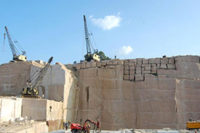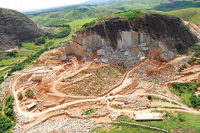The following is a look at selected quarry sites, including the machinery used (other than handling equipment), extraction methods and overall block production.
Giallo Triana marble Macael, Spain
Monthly Block Production: 1,000 cubic metersEquipment Used: Fantini chainsaws; Micheletti diamond wire saws; various drills
Tino Stone Group's site for Giallo Triana marble is in operation 24 hours per day six days per week. During the nighttime hours, the quarry is illuminated by electric light.
To extract the stone, the first step is to drill slots, and then the vertical and horizontal cuts are made with diamond wire saws and Fantini chainsaws. Once the cutting opera-tions are done, the quarry face is comprised of a series of large walls, and a specially fitted Caterpillar is used to pull each wall from the face and onto a cushion of sand.
The freed walls of stone are then cut into rough blocks, and diamond wire saws are used for the final trimming.
Overall, the quarry produces 1,000 cubic meters of stone per month. The typical block size is 5 to 6 cubic meters, with measurements around 295 x 190 x 180 cm.
Macael White marble Macael, Spain
Monthly Block Production: 700 cubic metersEquipment Used: Micheletti diamond wire saws; various drills
Tino Stone Group's quarry site for Macael White marble, one of the most renowned materials from the Andalucia region of Spain, sits at a steep pitch amid several large hills. Given the difficulty of the site and the geological formation of the stone, it takes some skill to hunt down areas of high-quality stone. Tino relies on a combination of core drilling and blasting - along with the experience of its workers - to find these prime areas for extracting stone.
Because areas of high-quality stone are scattered throughout the formation, it is necessary for Tino to work several smaller extraction areas within a single quarry. These extraction areas are worked until all of the useable stone is freed, and new areas are developed on a continual basis. The bulk of the cutting is done with Micheletti diamond wire saws, which are also used for final block trimming at the quarry site.
Production at Tino's quarry for Macael White marble currently stands at 700 cubic meters of stone per month. The stone blocks produced are relatively small, measuring 4 cubic meters or even as small as 2 cubic meters.
Crema Marfil marble Alicante, Spain
Monthly Block Production: 125,000 tonsEquipment Used: chainsaws with tungsten teeth; Micheletti diamond wire saws; pneumatic drills; splitters
The "El Monte Coto" quarry, owned by Esteve & MaEez, is one of the largest and most impressive extraction areas in the world. Presently, 1.5 million tons of natural stone are extracted from the site each year.
The extraction process relies on the combined effort of diamond wire saws and "jib shearers" - a style of chainsaws featuring tungsten teeth - to cut through large masses of stone at the quarries. The chainsaw makes vertical cuts, slicing the surface into equal sections to be removed from the quarry face. These sections are divided afterwards into usable blocks with pneumatic drilling and hammering with troncoconic splitters, which are introduced into the holes. Finally, the quarried blocks are taken to the production plants where they are processed into slabs, tiles or cut-to-size products.
Carrara White marble Carrara, Italy
Monthly Block Production: 1,650 tonsEquipment Used: Lochtmans diamond wire saws; Korfmann HSTK 450 gallery saws; Korfmann ST 50 VH open surface saw; Korfmann ST 450 VH open surface saw; Pellegrini derricks
The underground quarry operated by F.B. Cave and owned by Furrer S.p.A. produces Statuario White marble - the most exclusive variety of the Carrara marbles. The quarry is more than 60 meters deep and produces about 20,000 tons of material per year.
The quarry, which is almost 40 years old, began as an open air quarry during its first decade of operation, and the company began mining stone underground in 1973.
The company's equipment has also evolved over the years, as the company moved from machinery built in house to advanced equipment from Italy and abroad. This includes nine Lochtmans diamond wire saws, two Korfmann HSTK 450 gallery saws, a Korfmann ST 50 VH open surface saw, a Korfmann ST 450 VH open surface saw, two Pellegrini derricks, three loaders, and two Fiat-hitachi excavators.
The majority of the blocks produced, which include Venato and Venatino marble in addition to Statuario, are fabricated in Furrer's facility, and then distributed worldwide.
With around 15 workers, the quarry is in operation from 7 a.m. to 5 p.m., five days a week, year round.
Finnish soapstone Juuka, Finland
Monthly Block Production: 2,500 cubic meters (multiple sites)Equipment Used: Korfmann chainsaws (modified in-house); various drills
The soapstone quarries owned by Tulikivi of Juuka, Finland, are in operations most of the year, typically closing from mid-December to mid-February or whenever the temperature is lower than -25 degrees. The quarry operates three shifts, and the site is illuminated in the evening for night extraction.
The stone is freed from the quarry face with chainsaws, which cut both vertically and horizontally. The engine and saw mechanism are produced in Germany by Korfmann GmbH, and the equipment is heavily modified by Tulikivi's engineers, who create the structure, rails, cabin and hydraulics.
Each ledge within the quarry is approximately 7 feet, 4 inches high, and the vertical cuts are made 6 feet from the edge of the ledge. As a result, blocks typically measure 7 feet high x 6 feet wide in size, and the length depends on the natural break within the quarry. A Caterpillar front loader, which can accommodate weights up to 44,000 pounds, is used to remove blocks from the site. The quarry yield is approximately 10% for fireplace production, and waste is taken from the area after each shift.
Giallo Veneziano granite Nova Venecia, Brazil
Monthly Block Production: 4,000 cubic metersEquipment Used: Micheletti diamond wire saws; various drills
The granite that is extracted from the Giallo Veneziano quarry - operated by Granasa - Granitos Nacionais Ltda., of Nova Ven?a, Brazil - can be found in modern and classic designs around the world.
The quarry produces 4,000 cubic meters of this stone per month, and it has been in operation for 20 years. To meet this high production total, Granasa has crews extracting
stone from several faces of the massive quarry at a single time - working as many as of 14 different sites simultaneously. The stone is freed with a combination of drilling, blasting and sawing with Micheletti diamond wire saws. Once sections of the quarry are exposed, diamond wire saws are used to free large walls of stone from the quarry face. These large pieces of stone are then broken down into rough blocks with the drills, and finally trimmed with diamond wire saws.
Samoa Light granite Nova Venecia, Brazil
Monthly Block Production: 1,900 cubic metersEquipment Used: oxygen burners' Rochaz diamond wire saws; various drills
The quarry for Samoa Light granite, is located near Nova Venec? Brazil, and owned by Rocha Branca Minera? Com?io e Exporta? Ltda. Although much of the material has a yellow tone, some sections of the quarry also produce a white material.
The quarry is relatively new, as it opened during the first half of 1999, and it produces 1,900 cubic meters of material per month.
To extract the stone, oxygen burners create large vertical channels in the quarry, and diamond wire saws from Rochaz, a Brazilian firm, are also used to make smaller vertical cuts. Large sections of the quarry wall are then separated from the quarry face, and they are then formed
into blocks.
A total of 40 workers are present at the site, and the company is working multiple areas of the quarry.
American Black granite Morgantown, PA
Monthly Block Production: 400 cubic metersEquipment Used: Tamrock drills; Pellegrini diamond wire saws
Pennsylvania Granite Corp.'s quarry for American Black granite, which was purchased by Rock of Ages in 1997, has rapidly increased production over the past five years. With upgraded machinery and the financial backing of Rock of Ages, the company has increased production and efficiency in a short time, and it is selling 100% of its production to a worldwide market.
With 12 workers, the quarry produces approximately 400 cubic meters of material per month. The quarry operates one shift 12 months per year, and the material recovery rate currently stands at about 15%. Equipment in the quarry includes five Tamrock drilling rigs as well as three Pellegrini diamond wire saws. In the past, representatives from Rock of Ages have worked directly with the engineers from Tamrock's plant in Finland to help in developing drilling equipment that is suited for the specific characteristics of their quarries.
The Pellegrini wire saws are also utilized for maximum efficiency in the quarry, as they cut vertically as well as horizontally. A typical block size is 6 to 10 feet long x 5 feet wide x 3 to 6 feet high.
Vermont slate Poultney, VT
Equipment Used: jackhammers; drilling rigs; manual hammers and chisels; front end loaders; off-highway dump trucks; hydraulic and air drills; air compressors; hydraulic excavatorLocated in Poultney, VT, the 55-year-old quarry for Tatko Brothers and Sheldon Slate Products holds four different varieties of slate - gray, green, purple and dark green. But to extract the useable slate from the earth, as much as 40 to 70 feet of overburden must be removed to reach the "pillars" of good slate underneath. Overburden is blasted using "delay blasting" techniques, which better utilize the explosives while also minimizing ground vibration and air blast. When useable slate is reached, a "softer hit" of black powder is used to loosen the blocks. Even during busy periods, however, blasting is infrequent - taking place less than once a week.
After the excess stone is removed with an excavator, a jackhammer run by an air compressor is used to drill and loosen large pieces of slate. The slate is then cleaved with a hammer and chisel, which splits the stone along its natural veining.
Due to of the geological characteristics of the stone, quarrying operations must follow the natural seams formed by the slate within the earth, and the quarry bed is pitched at as much as a 45-degree angle. Since the nature of the quarry can be unpredictable, the company is constantly seeking new areas at the site to extract high-quality stone.
The quarry operates 12 months per year, but due to the natural characteristics of the slate, care must be taken to ensure that the stone does not freeze (once frozen, the slate cannot be split). When faced with temperatures below 15 degrees, exposed faces of stone within the quarry must be covered, and any stone that has been extracted must be taken directly inside the mill or a heated storage area.
Once slabs of stone are freed from the quarry face, an air hammer is used to split the larger pieces of slate. The stone is then loaded onto the trucks, and they are transported to the mill. Pieces of stone are graded in the pit, and they are delivered to one of several mills - depending on what final product they are suited for. For larger stones, the company looks to fabricate high-value products such as countertops or other structural work, while smaller pieces are used for tiles, flagstone or roofing slate.
Rockville White granite (Quarry #2) Cold Spring, MN
Monthly Block Production: 20,000 cubic metersEquipment Used: slot drills with a custom drilling head
Cold Spring Granite Co.'s Rockville #2 quarry typically produces about 20,000 cubic feet of material per month, which is used for structural building, mausoleums and markers. There are two slot drills and several Tamrock primary drills on site. The change to slot drilling was relatively recent for Cold Spring, which changed methods because the L-blasting technique was resulting in a lower overall yield. Cold Spring also designs and builds a custom head for the drilling units. The end product is a trimmer drill with 360-degree rotation and a 40-foot extension on the boom, and similar drills are in use in most Cold Spring quarries.
Another improvement at the quarry was the introduction of "Lean Manufacturing" principles of efficiency. These time- and energy-saving steps were patterned after those taken by companies such as Toyota Motor Corp., which is considered to be the world model. Within the quarries, new methods have been implemented to save time and money. As part of this system, the company will free a loaf of stone, but they will not extract stone until they receive a customer's request. This allows them to do more cut-to-size work, rather than storing blocks that may not fit a specific request.
The company also reduced fuel costs of building a block yard right on site. Additionally, waste from the quarry is now efficiently managed. Cold Spring stockpiles the material, which is broken down about every two or three months, and then a company comes in twice a year to crush the stone for use as aggregate or asphalt.


